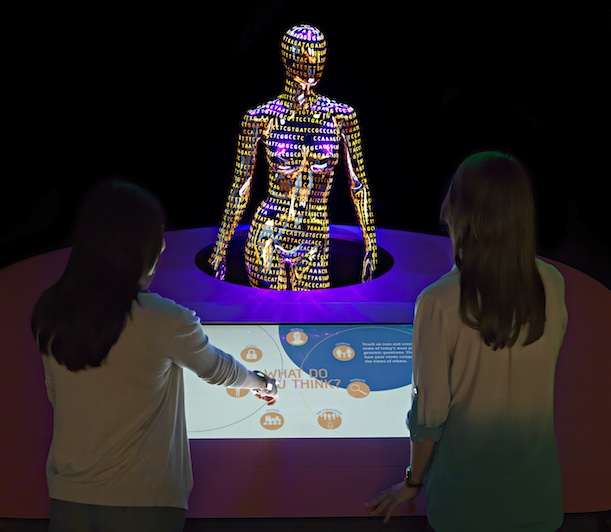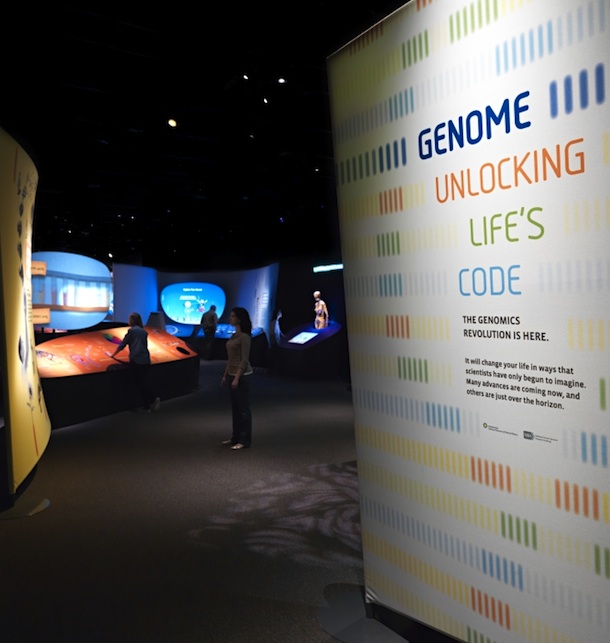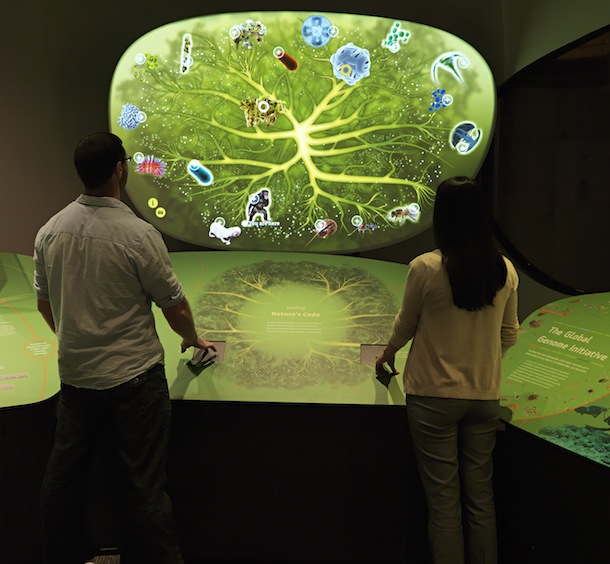Unlock the Science and Ethics of the Human Genome in a New Exhibit at the Natural History Museum
The new exhibition celebrated 60 years of genetic research and makes it accessible to large audiences

“Genome: Unlocking Life’s Code,” a new exhibition about developments in genomic research, opened at the Natural History Museum today. All photos: Donald E. Hurlbert and James Di Loreto, Smithsonian
Today, the National Museum of Natural History opens a new multimedia exhibition that’s all about the stuff that makes you you.
“Genome: Unlocking Life’s Code” examines the instruction manual built into all living things: the genome, an organism’s hereditary material bundled up in the nuclei of every one of its cells.
The exhibition, which was created in collaboration with National Human Genome Research Institute, part of the National Institutes of Health, covers 4,400 square feet with interactive games, 3D models, DNA sequencing equipment and videos of real-life stories. It aims to show the relevance of modern genomic research to everyday life as genetic sequencing becomes increasingly accessible.
Marking the 10th anniversary of the completion of the Human Genome Project as well as the 60th anniversary of Watson and Crick’s discovery of DNA’s double helix structure, the exhibition traces the major advances in human health, disease studies, ancestry and other natural sciences that have occurred since the genome project’s completion. It also looks ahead to how genomics will influence our lives as genetic sequencing becomes increasingly easy and inexpensive.
“Genomics is highly relevant, because it’s in the news every day, so people have a broad awareness of this topic, but almost no specific knowledge,” says Kirk Johnson, the Sant Director of the National Museum of Natural History. “You read the paper, and there it is, boom, but what does it mean when the police have my DNA? This exhibition helps to answer questions like this.”

The 4,400 square-foot exhibition includes interactive games, 3D models, DNA sequencing equipment and videos of real-life stories
In just the past few weeks, the Supreme Court ruled on two major decisions on genomic research: On June 3, the court ruled law enforcement could collect DNA from anyone who has been arrested. On Thursday, it then ruled naturally occurring human DNA could not be patented. Additionally, Angelina Jolie recently decided to get a preventative double mastectomy based on her predisposition to breast cancer as identified by genetic sequencing.
Genomics’ future raises major ethical questions surrounding human cloning, genetic engineering and prenatal genetic testing.

Visitors explore one of the exhibition’s many interactive displays
To address the array of complicated issues surrounding genomic research, the exhibition features four themed areas that cover what the genome is, how it relates to medicine and health, how it connects humans to all life and how it is part of each persona’s individual story. The displays are designed to be adaptable, with physical pieces and digital content that can be rearranged and replaced so that the displays can change as the field advances.
Johnson stresses the exhibition’s capacity to inspire the next generation of scientists who will have to come up with answers to genomics’ big questions. “Out of the millions of teenagers that will visit this exhibition,” he says, “some are going to walk in and go, you know, this is cool. We’re at the edge of this major biomedical revolution, and eighth graders, in 20 years, are going to be 32 -year-olds, and they’re going to be the ones prescribing our medicine. Science is often perceived as hard and boring in classrooms, so we want to break through that stereotype by making things fun and interesting.”
Eric Green, director of the National Human Genome Research Institute, believes the exhibition also will help assuage fears of genomics’ future. “Much of what people fear about genomic research is what they don’t understand,” he says. “So this exhibition gives visitors a foundation to think critically and in a more sophisticated way.”
“Genome: Unlocking Life’s Code” will be open in the Natural History Museum through September 1, 2014, after which it will travel around North America for about five years. To learn more about genomics, visit the exhibition’s website and check out Smithsonian Magazine’s own special report on the topic.
/https://tf-cmsv2-smithsonianmag-media.s3.amazonaws.com/accounts/headshot/paul-bisceglio-240.jpg)
/https://tf-cmsv2-smithsonianmag-media.s3.amazonaws.com/accounts/headshot/paul-bisceglio-240.jpg)